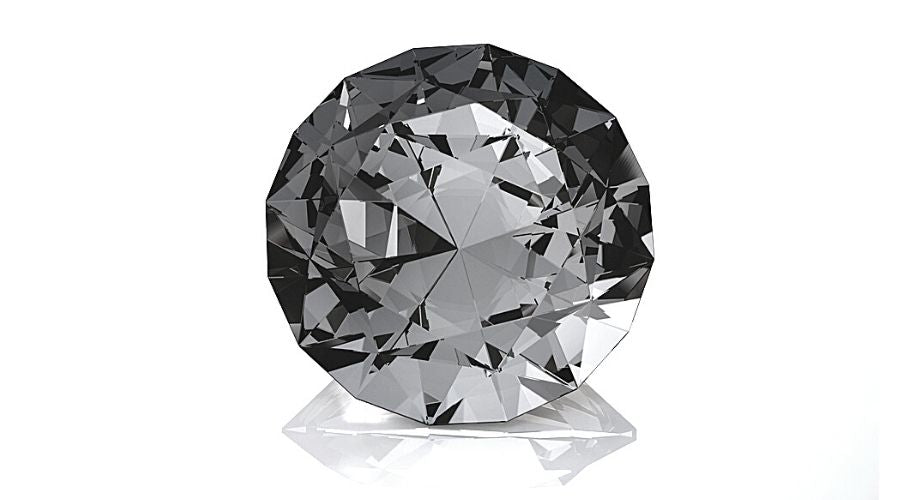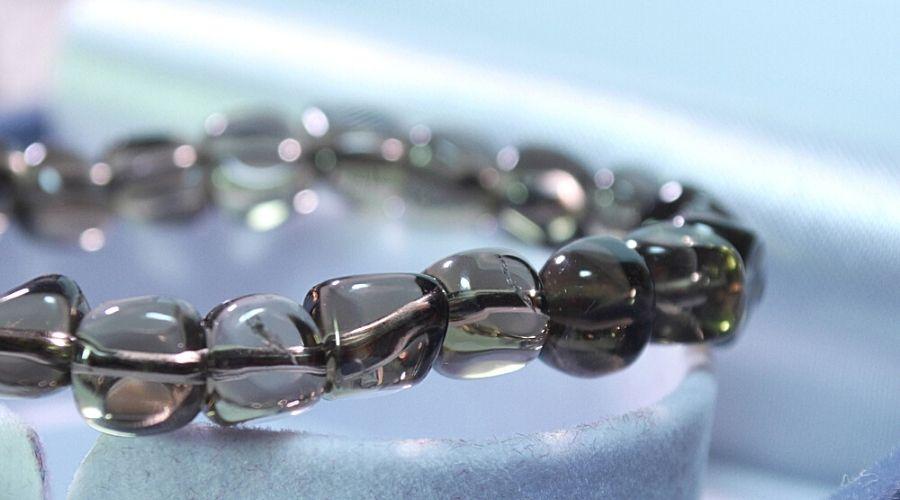
When it comes to picking out jewelry, a lot of people tend to opt for bold colors. Vibrant reds, emerald greens, and deep blues may sell out before gray gemstones do. In comparison, gray gems may feel less flashy, but there are a couple of reasons why they should be your first pick.
As a neutral hue, not only does gray go with just about every skin tone and outfit, but the color also symbolizes balance, elegance, and intellect. If you want to add some gray jewels to your collection, here are the top gray gemstones to keep your eye on.
Top 11 Gray Gemstones
From moonstone to pearls, here are eleven gray stones that suit any occasion and outfit.
1. Gray Agate

Agate stones symbolize strength and courage and come in a range of colors, including gray. Gray agate stones can be completely gray, but it’s more common to find the gray coloring interwoven with layers of white.
Since it’s translucent and smooth, you may find agate in large costume pieces. Regardless, this affordable stone goes with almost any kind of setting.
Gray agate doesn’t require a lot of upkeep or maintenance. It is also quite durable, ranking a 7 on the Mohs scale. One con, though, is that it might be hard to find unicolor gray agate.
2. Gray Chalcedony

Gray chalcedony is known for its durability and tends to be more opaque than translucent. It ranks near a 7 on the Mohs scale due to its microcrystalline structure. Not to mention, gray chalcedony doesn’t have any cleavage. As a result, you don’t have to worry about it breaking or fracturing.
In regards to healing, chalcedony absorbs negative energy and promotes harmony and alignment. Some positive qualities of gray chalcedony are that it doesn’t have any cleavage and is affordable and readily available. The only negative is that it is not as revered as some other stones.
3. Gray Diamonds

You may have heard of pink diamonds and white diamonds, but what about gray diamonds? These gems have slowly become more popular, with coloring that ranges from charcoal gray to silver or pigeon gray. They originate all over the world, including Russia, India, and Brazil.
A diamond’s gray coloring comes from the extra hydrogen in the gem’s chemical composition. Compared to other types of diamonds, gray diamonds are a more neutral option offering the same durability. They also tend to be more affordable than other colored diamonds.
Gray diamonds are just as strong as their white and colorful counterparts. The primary downside is that they are less valuable than most other diamonds.
4. Gray Fluorite

Fluorite has a reputation for its vivid coloration, and gray fluorite is no exception. Fluorite comes in a variety of colors, including all shades of gray. When it comes to symbolism, fluorite gems are associated with cleansing the body and helping concentration.
Compared to other gems, fluorite isn’t as hard, so it’s more common to see this gem used in ornaments rather than jewelry. Still, it makes for an eye-catching bracelet, necklace, or pair of earrings. The vibrant coloration makes it a standout gem in any setting.
5. Gray Hematite

You can easily find this iron-rich stone in varying shades of gray, including dark charcoals and light silvers. Most people recognize hematite by its metallic-like luster that makes it shine in any piece of jewelry. Since it’s more reflective than many other crystals, you can often find it in necklaces, bracelets, and rings.
Spiritually, hematite is a stone for protection and grounding. It also absorbs negative energy and provides a sense of calm in stressful situations. Unfortunately, it is somewhat brittle, meaning it’s more prone to breaking or cracking.
6. Gray Labradorite

If you ask about gray gemstones, you’ll probably hear someone mention labradorite. This tends to be one of the most popular gemstones that comes in gray.
While it may look similar to moonstone, labradorite often contains visible inclusions. More translucent labradorite stones may have hematite patterns inside of them.
When you wear it as jewelry, labradorite is said to block negative thoughts. It’s also associated with reducing fatigue and stress. The price tag makes gray labradorite a popular gemstone, though it may not be as vibrant as other gray stones.
7. Gray Moonstone

When you think of moonstone, you might picture a translucent, white stone. Though less common, moonstone can have yellow, blue, brown, and gray coloring as well. Any moonstone, including gray moonstone, is believed to harvest the energy of the moon, so you’ll want to treat your moonstone with care. Symbolically, these are “lover’s stones,” and they represent passion, love, and friendship.
Their smooth texture and luster (especially when they shine under the moonlight) make this a beautiful stone fit for anyone. Moonstone has strong meanings associated with love and passion. Its smooth texture and translucent coloring are also unique.
Unfortunately, moonstone is somewhat fragile and prone to breakage. The gray coloring also tends to be more subtle than in other stones.
8. Tahitian Pearl

Not only are they the birthstone for June, but pearls symbolize wisdom, longevity, and purity. You may already be familiar with white pearls, but these gems can also come in blacks and grays as well.
Since Tahitian pearls may have pistachio or eggplant coloring, you may not always see them fall under the category of gray gemstones. We categorize their dark, luminous coloring as a gray gem. Depending on the pearl, some Tahitian pearls may look more green-gray or purple-gray.
9. Gray Sapphire

While sapphires may traditionally be blue, you can find them in a wide array of other shades, including pink, yellow, green, and gray. These are high-grade gems, third only to diamonds and rubies, and they’re highly sought-after.
Sapphires are luminous and symbolize honesty, longevity, and loyalty. They are also the birthstone for September. Though sapphires are expensive, they are durable and make a worthwhile investment.
10. Gray Spinel

Ranking at an 8 on the Mohs scale, gray spinel is one of the more durable stones you can buy. One unique characteristic about spinel is that its singly refractive. When a single ray of light enters, a single ray leaves. Diamonds share this quality.
You can get spinel in almost every shade, including gray. Because there’s so much variety, this gem is usually associated with revitalizing your chakras. A gray spinel is an affordable option, though difficult to find in completely neutral tones.
11. Gray Tourmaline

Tourmaline is meant to promote happiness and bring love to those who wear it. While gray tourmaline is somewhat rare, you can also find this gem in blues, reds, purples, and even translucent, colorless shades if you desire.
Tourmaline is quite a hard stone, with a 7-7.5 rating on the Mohs scale. Gray is also one of the rarer shades of tourmaline.
Other Prominent Gray Gemstones
There are a couple of other prominent gray gemstones worth mentioning, such as:
Mother of Pearl

Mother-of-pearl is believed to increase intuition and imagination while attracting prosperity. While you may not find it in dark gray shades, it can come in light grays and off-whites. So, if you’re looking for a gray gemstone with a more subtle appearance, this may be the right pick for you.
Tourmalinated Quartz

With black tourmaline and crystal, most tourmalinated quartz has a light gray coloring and darker, black inclusion. These give this gem an eye-catching look. This stone isn't just pretty, though. It has heavy associations with reducing negative emotions while also protecting the wearer.
Gray Gemstones: Conclusion
While it’s not uncommon to find jewelry in vibrant reds or blues, spotting gray gems is a lot rarer. Adding one to your collection can instantly add a classy, sophisticated charm to any outfit or occasion. And, since neutral colors are on the rise, gray gemstones are likely to only grow in popularity.
Keep in mind that traditional jewelers may not always have a lot of gray gemstones in stock. Shopping online can provide tons of variety and make it easier to find the specific gem you’d like.






Leave a comment